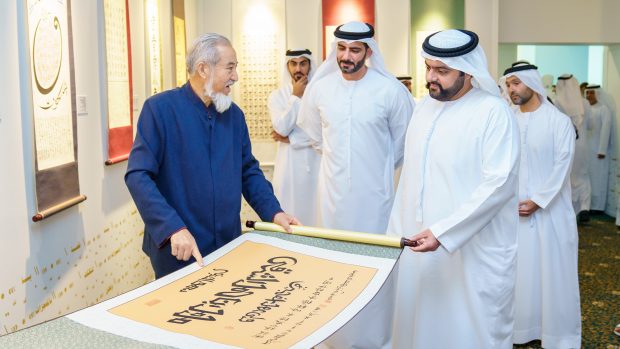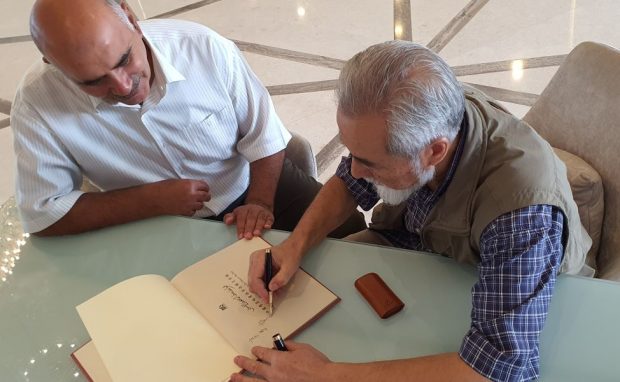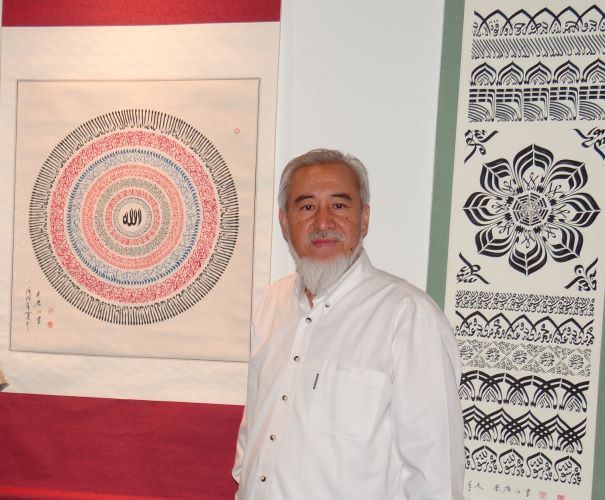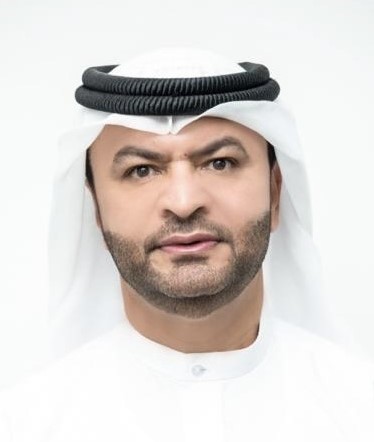
At Al Bader Festival, brush, qalam produce graceful Sini calligraphy

FUJAIRAH: The first participation of Haji Noor Deen Mi Guang Jiang, a renowned Chinese master of Arabic calligraphy, at Al Bader festival in Fujairah in the United Arab Emirates brought him a combination of elated feelings, happy impressions and wishes to be part of the festival next year.
“This is my maiden participation in Al Bader Festival along seven other calligraphers from China,” he said.
“We displayed Sini calligraphy where the Chinese and Arabic calligraphic traditions, often seen as two of the world’s finest manifestations of the written word, combine techniques and styles in an artistic piece that is a work of incredibly unique beauty.”
At the festival, Haji Noor Deen, inspired by Chinse and Arabic calligraphic traditions, created works with expressive shapes that at first glance appear Chinese lines, but on closer inspection are Arabic letters.
The Sini script allows the calligrapher much more freedom of expression than the Arabic calligraphy with its stricter rules.
In the Sini script, the words can be written from top to bottom, bottom to top, right to left and from the middle outwards.

In his work, the Chinese artist who speaks and writes Arabic fluently, uses a brush characteristically used for Chinese calligraphy to paint the Arabic letters, combining it with the qalam, a pen made from a cut, dried reed for Arabic calligraphy.
“We also participated in an interactive workshop on the Arabic script,” said the 60-year-old calligrapher who brought an immense learning in traditional thought and Islamic art to a modern audience, juxtaposing them in a new calligraphic style all his own, both Eastern and Western.
Born in 1963 in the Shandong Province, China, Haji Noor Deen’s interest in calligraphy began as a teenager.
When he was 18, he started studying Arabic Calligraphy when he had to hand-copy the books from their professor. His early talent made him the first Chinese Muslim to receive the Egyptian Certificate of Arabic Calligraphy and induction as a member of the Association of Egyptian Calligraphy.
His mastery of Arabic calligraphy and his unique style have made and consolidated his reputation and his calligraphy mastery took him to exhibit and lecture at Harvard University, Cambridge University, UC Berkeley, MIT, the Bukhari Institute, Islamic College in Zhengzhou, China, the Zaytuna Institute in California, and many others, said that he takes home fond memories of his participation in Al Bader Festival.

“I am very pleased with the festival and with the ample cultural opportunities it has offered to all people. I have been to many festivals, but Al Badr Festival in Fujairah holds a special significance thanks to its outstanding features, smooth organization and genuine care,” he said.
“I was also touched by the dedication and commitment of the festival organizers who made it very easy for all the participants.”
The second edition of Al Bader Festival, held under the patronage of Fujairah Crown Prince His Highness Sheikh Mohammed bin Hamad Al Sharqi, featured exhibitions, workshops, spiritual chants, and an operetta.
The exhibition included more than 56 works of art, including ebru and patchworks with Turkish and Persian motifs, combining diverse artistic styles.

“In its edition this year, the festival spotlighted various Islamic arts and hosted the works of the most important and prominent artists of decoration and Arabic calligraphy from China, Turkey, Egypt and the United Arab Emirates,” Dr. Ahmed Hamdan Al Zeyoudi, the Director of HH the Crown Prince’s Office, said.
“The festival is an important international event that builds on the keen interest and strong support of the Crown Prince of Fujairah His Highness Sheikh Mohammed bin Hamad Al Sharqi for cultural festivals that highlight the religious and social characters of Islamic societies, promote the principles and ethics of the Prophet’s life and document the lessons learned from its various stages, and highlight the Islamic culture through arts and literature while sharing them with the world.”
The festival also celebrated the spirituality expressed in poems praising the Prophet. The aim is to highlight the rich cultural, social and religious heritage of the Arabs in expression their love and admiration of the Prophet (PBUH) and their celebration of his auspicious birth, Dr. Al Zeyoudi added.
The festival coincided with the commemoration of the birthday of Prophet Mohammed (PBUH).


